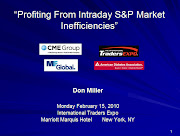The Big Picture - First, one of the things that drives me crazy in this often overly-hyped business is the focus on the short term. The immediate. The last trade. The "I called the market right!" syndrome".
And we've discussed the concept of "time" many times in this journal, including the often quoted and syndicated Svithjod Rock post, as well as recently in great detail in my May 1 post on Delayed Gratification.
In the Jellie Webinars (which if you're new to this trek chronicle in painstaking 16-Hour detail the eight weeks of the beta Jellie Team's experience -- with a portion going to the American Diabetes Association), the first of the eight sessions references that trading is essentially the "long-term accumulation of short-term decisions".
I remember when we launched the Jellie program, that one observer commented something along the lines of, "well, just wait until he has his first blunder ... that will be the quick end of it". Yet, I knew that years of trading and teaching experience had taught me quite the opposite. In fact, I couldn't wait to make, discuss, and analyze that first "blunder" with the team, and that "blunders" are simply result of lesser probability outcomes -- whether it be the lesser probability of a high % chart setup, or the lesser probability that you've misread something or are simply off your game when you're on it the vast majority of the time.
And from my earliest days of mentoring traders to current efforts, realizing that trading is all about imperfection remains one of the #1 "light bulbs" for every participant ... which often immediately puts them at ease.
When I taught traders in the late 90s and early 00's, it didn't take but a few days to quickly realize that the industry -- which at the time was in its "rah-rah no one ever has a loss, but don't hold the chatroom auction caller responsible when he does" hey day -- had substantially left the terribly misguided impression that successful trading didn't include the losses, or the occasional -- yet highly necessary -- pain. Because it wasn't discussed. And frankly, in many cases, it wasn't allowed lest you be banned.
The result was that many people entering trading in this new era where markets became more accessible via the Internet were missing perhaps the most important piece of the puzzle. Or in other words, they were being told all about the lock -- how it looked, its composition, its role, and how great the locksmith who made it was -- but not handed the key. Frankly, it was sometimes because the locksmith didn't even have the key. He just had a fancy lock.
Now some may argue that I've overcompensated by discussing and venting about my occasional struggles more than my successes. Or that I'm a "downer". To that, you can ask any of the Jellies on Thursday morning when I was literally screaming my personal sequence ala Lewis Winthorpe on the early bear trap -- buying every dip-- before unloading it all on the 3rd and final push to 1094. It was fun, and I thoroughly enjoyed and briefly celebrated it for a few minutes before closing up shop for the day.
Yet it's still all about the long term. And such is why the live Jellie program and Webinars span multiple weeks. Because they have to. Do they replace the years of experience that must be developed and nurtured? Of course not. Yet if one is going to get formal instruction, you have to start with something that begins to emphasize that trading is far more than a trade, day, hour, or week.
 Case in point. To the right is a random sort and scatter graph of my actual trading results over a sample time span (click to enlarge). The red line in the middle reflects zero, the dots above reflect positive days (the higher, the more profitable), and the dots below reflect negative days.
Case in point. To the right is a random sort and scatter graph of my actual trading results over a sample time span (click to enlarge). The red line in the middle reflects zero, the dots above reflect positive days (the higher, the more profitable), and the dots below reflect negative days.And the first thing that may surprise you is the amount of dots below the line -- including some far to the south -- which at first glace may lead many to think the net result probably is break-even at best. Look at it. Stare at it. And look again at the points to the south which we'll call ... well ..."blunders".
Far from it.
For the net result of this "long-term accumulation of short-term decisions" -- blunders and all -- is well over two million dollars.
Further, as I've always said, I consider the dots below the line to simply reflect business expenses -- which is how I book them. Necessary expenses which allow the "revenues" to the north to be generated.
And when we begin again on Tuesday? Well for me, one fun part of this business is never caring about knowing where that next "dot" will land -- while knowing full well what the long-term outcome will be.
Now, on to my second thought.
 Who Wants It More? After last night's Orlando Magic series loss to the Celtics, Dwight Howard referenced that at the level of the Eastern Conference finals where talent is essentially equal, it ultimately comes down to who wants it more.
Who Wants It More? After last night's Orlando Magic series loss to the Celtics, Dwight Howard referenced that at the level of the Eastern Conference finals where talent is essentially equal, it ultimately comes down to who wants it more. This time around, the Celtics simply wanted it more -- diving for every loose ball and giving up only the rare uncontensted lay-up without fouling to make Orlando earn it from the free throw line. Minute by minute, game by game ... they were relentless. And it showed in the final result.
And isn't it so true with trading.
Personally, my long term P&L is only driven by how bad I want it. Only.
So how bad do I want it right now?
More importantly, how bad do you want it right now?
Are we willing to make the sacrifices?
Are we willing to dive for loose balls?
Are we willing to buy hard after the selling has stopped and sell hard after the buying has stopped?
Are we willing to fight for those fricken "Missing Inches"??? (You HAVE to read that post of one year ago to the day and watch the video if you haven't before. My guess is that you're leaving several yards of missing inches on the table.)
For our answer will largely determine where all future dots will land on our graph.
Over time, of course.
Have a wonderful and restful weekend.

















6 comments:
Another very fine and eloquent stream of thoughts Don. I loved the scatter plot graph. Yet again you find a unique and interesting way of "telling it like it is". One of your particular talents. (in fact IMHO that could be a sub-heading for the blog)
Thanks.
Great scatter plot Don!
It really illustrates what you've always taught about viewing performance in the bigger time frame rather than from under a microscope.
To see it from another angle try converting each data point to reflect the percentage it was of available trading capital at that time. Maybe it will help your brain to finally get the point on the position sizing issue as your account size changes.
I bet you'll find too that the May 6th episode was really just the loss of a fingernail rather than the whole finger. Besides, fingers usually don't grow back in three weeks... unless you're Don Miller of course!
Nice job as always. Thanks again.
Great idea Doug. I'm going to give that a try. Don
Hi Don,
The "scatter plot" image is the clearest "explanation" of what to expect of successful trading I've come across....wish I had thought of communicating it as effortlessly and succinctly - if okay with you, I will link to this
Link away TradingEdge.
That scatter plot is the only thing you needed to convince everyone of how real your trading is.
2 secs is enough to see the positive expectancy of your trading style. Kudos.
Post a Comment